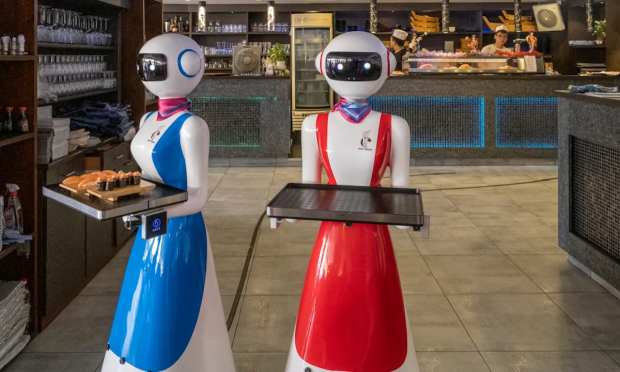Automation In Foodservice And Prep Eases Restaurant Labor Shortage Challenges

How much do you tip a robot? Consumers may be asking themselves this question soon — foodservice technology company Botrista announced on Monday (June 28) that it had raised $10 million in Series A funding, bringing the company’s total to $16 million, to roll out its DrinkBot robot barista across the United States. The robot prepares complex beverages, such as latte drinks, teas and more, in under 20 seconds, taking orders through its touchscreen. The funding for this turnkey solution, which serves as both an order taker and an order preparer, arrives as many foodservice establishment operators are looking for solutions to meet consumer demand amid the labor conditions impacting both front- and back-of-house operations.
“While craft beverages are trending, it has become increasingly challenging for foodservice companies to meet demand due to labor shortages and lower staff retention,” Sean Hsu, co-founder and CEO of Botrista, said in a statement. “With nationwide expansion plans, these companies will have the opportunity to drive new revenue with the DrinkBot.”
In another $10 million fundraise for foodservice automation, food technology company Soft Robotics announced its Series B haul on Tuesday (June 29). The company creates artificial intelligence (AI) solutions for various parts of the food supply chain — agriculture, processing and more. In a statement, Mark Chiappetta, COO at Soft Robotics, pointed out today’s “labor-challenged food supply chain,” adding that more sophisticated robots are needed “to perform tasks that traditionally could only be performed by human workers.”
Earlier this month, McDonald’s was reported to be pilot-testing AI-enabled drive-thru, processing voice orders four times out of five without human intervention. Many other restaurants’ drive-thrus are also testing out automated solutions to make the process more efficient with less labor. These sorts of solutions can be key right now, at a time when restaurants need to fulfill more orders with fewer hands.
“Part of the labor shortage is … driven by digital orders, which grew tremendously during the pandemic and aren’t going away — so digital orders mean that you can get many, many more orders instantaneously than you could ever get with a walk-in, a call-in, or a sit-down customer base,” Clayton Wood, chief executive officer at robot-as-a-service (RaaS) company Picnic, told PYMNTS. “It’s an operational challenge … but it’s an opportunity for those who can get the right technology applied.”
Restaurants are trying out robotic waiters, robotic food preparation solutions and robotic delivery options. Of course, not all robotic solutions prove to be viable long-term. Take, for instance, the story of Pepper, SoftBank’s service robot, which served as something of a mascot for the company — it was revealed this week that the company is discontinuing production of the consumer-facing, emotion-reading robot that proved less popular than predicted commercially. Still, the company’s robotics investments are hardly tanking — the company just sold its robotics firm Boston Dynamics to Hyundai for $1.1 billion.
“Pepper did a lot to harm genuine robotics research by giving an often false impression of a bright, cognitive being that could hold conversations,” robotics expert Dr. Noel Sharkey told the BBC. “It was mostly remote-controlled with a human conversing through its speakers. Deceiving the public in this way is dangerous and gives the wrong impression of the capabilities of AI in the real world.”
With the use of automation, Wood told PYMNTS, restaurants “can see a more efficient, more profitable operation that can create more interesting jobs, and have a more successful business.”
